Marketing Plan for Nike's New Athletic Footwear: MG1062
VerifiedAdded on 2022/05/05
|13
|3142
|36
Report
AI Summary
This report presents a comprehensive marketing plan for Nike's new athletic footwear, examining various aspects of its strategy. It begins with an executive summary and introduction, followed by an overview of Nike's business, sales and profit trends, market share, and business sector. The report then delves into a detailed marketing environmental analysis, including PEST-G and SWOT analyses, along with competitor analysis to understand the competitive landscape. Recommendations are provided, focusing on target market identification, positioning, and the 4Ps of marketing (Product, Price, Place, Promotion). The analysis covers Nike's strengths, weaknesses, opportunities, and threats, offering insights into its marketing approach and strategies for success in the athletic footwear market. The report concludes by highlighting key strategies and recommendations for Nike's marketing efforts.

“MG1062 Principles and Practice of Marketing”
Marketing Plan
Name of the Student
Name of Institute
Date
1
Marketing Plan
Name of the Student
Name of Institute
Date
1
Paraphrase This Document
Need a fresh take? Get an instant paraphrase of this document with our AI Paraphraser
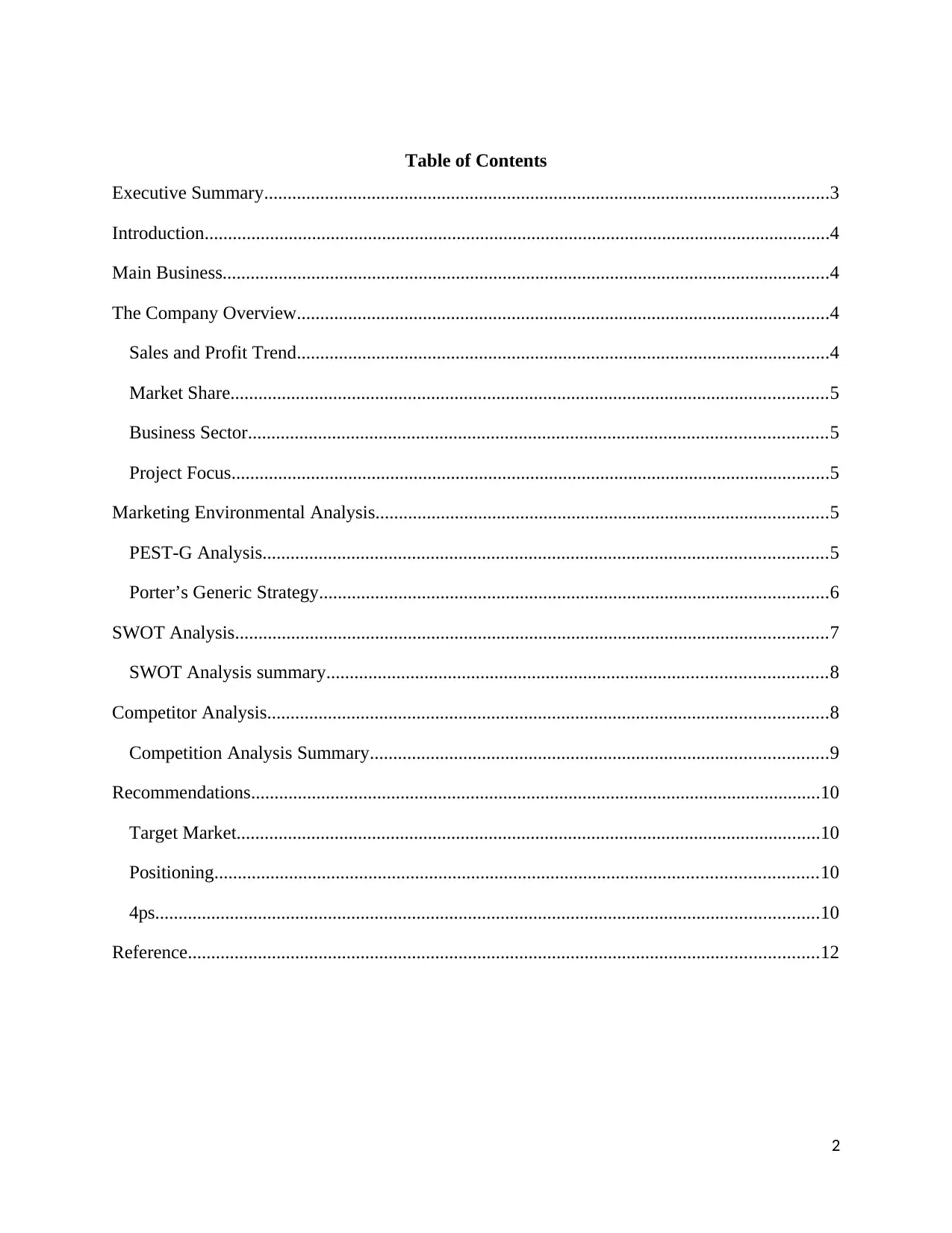
Table of Contents
Executive Summary.........................................................................................................................3
Introduction......................................................................................................................................4
Main Business..................................................................................................................................4
The Company Overview..................................................................................................................4
Sales and Profit Trend..................................................................................................................4
Market Share................................................................................................................................5
Business Sector............................................................................................................................5
Project Focus................................................................................................................................5
Marketing Environmental Analysis.................................................................................................5
PEST-G Analysis.........................................................................................................................5
Porter’s Generic Strategy.............................................................................................................6
SWOT Analysis...............................................................................................................................7
SWOT Analysis summary...........................................................................................................8
Competitor Analysis........................................................................................................................8
Competition Analysis Summary..................................................................................................9
Recommendations..........................................................................................................................10
Target Market.............................................................................................................................10
Positioning.................................................................................................................................10
4ps..............................................................................................................................................10
Reference.......................................................................................................................................12
2
Executive Summary.........................................................................................................................3
Introduction......................................................................................................................................4
Main Business..................................................................................................................................4
The Company Overview..................................................................................................................4
Sales and Profit Trend..................................................................................................................4
Market Share................................................................................................................................5
Business Sector............................................................................................................................5
Project Focus................................................................................................................................5
Marketing Environmental Analysis.................................................................................................5
PEST-G Analysis.........................................................................................................................5
Porter’s Generic Strategy.............................................................................................................6
SWOT Analysis...............................................................................................................................7
SWOT Analysis summary...........................................................................................................8
Competitor Analysis........................................................................................................................8
Competition Analysis Summary..................................................................................................9
Recommendations..........................................................................................................................10
Target Market.............................................................................................................................10
Positioning.................................................................................................................................10
4ps..............................................................................................................................................10
Reference.......................................................................................................................................12
2
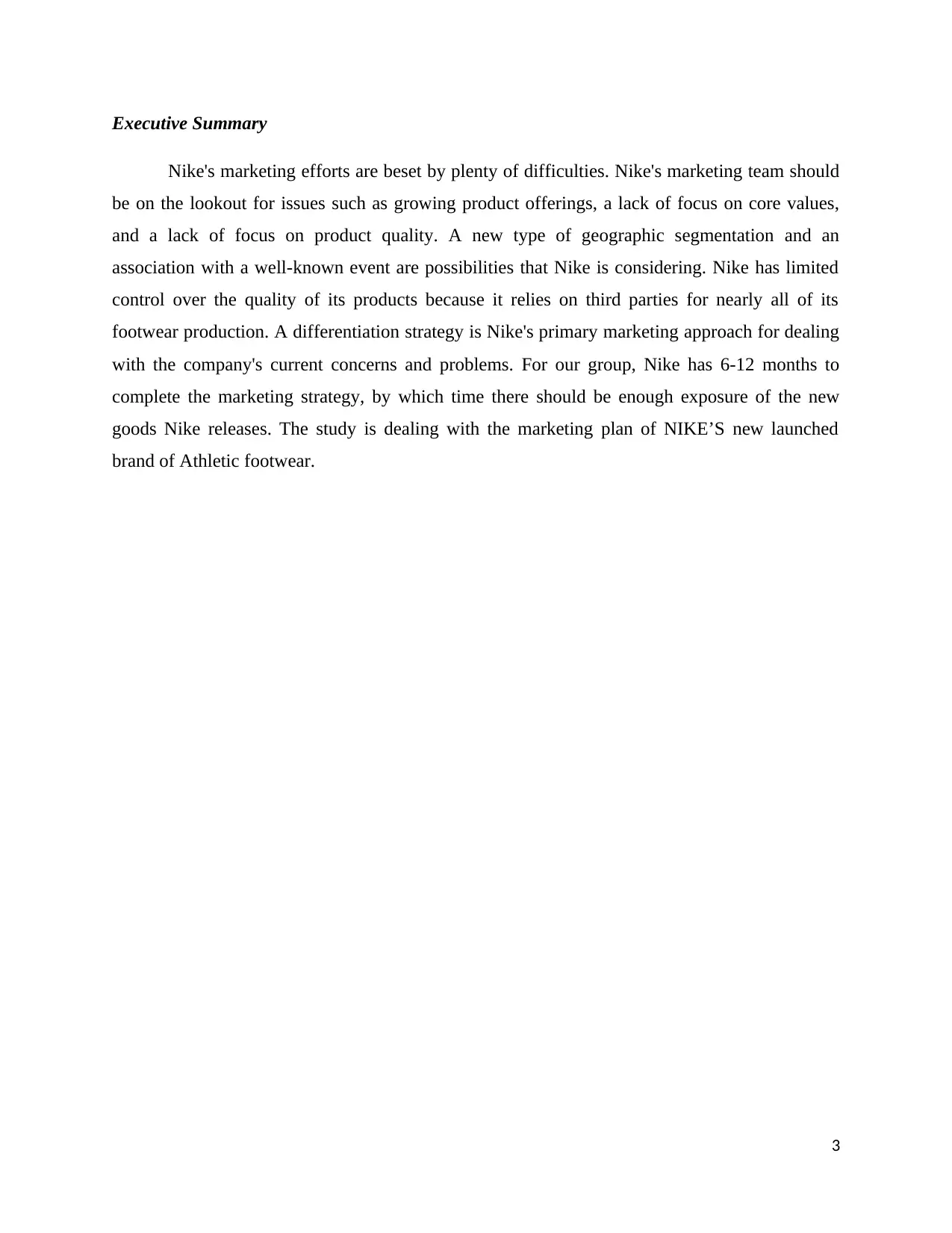
Executive Summary
Nike's marketing efforts are beset by plenty of difficulties. Nike's marketing team should
be on the lookout for issues such as growing product offerings, a lack of focus on core values,
and a lack of focus on product quality. A new type of geographic segmentation and an
association with a well-known event are possibilities that Nike is considering. Nike has limited
control over the quality of its products because it relies on third parties for nearly all of its
footwear production. A differentiation strategy is Nike's primary marketing approach for dealing
with the company's current concerns and problems. For our group, Nike has 6-12 months to
complete the marketing strategy, by which time there should be enough exposure of the new
goods Nike releases. The study is dealing with the marketing plan of NIKE’S new launched
brand of Athletic footwear.
3
Nike's marketing efforts are beset by plenty of difficulties. Nike's marketing team should
be on the lookout for issues such as growing product offerings, a lack of focus on core values,
and a lack of focus on product quality. A new type of geographic segmentation and an
association with a well-known event are possibilities that Nike is considering. Nike has limited
control over the quality of its products because it relies on third parties for nearly all of its
footwear production. A differentiation strategy is Nike's primary marketing approach for dealing
with the company's current concerns and problems. For our group, Nike has 6-12 months to
complete the marketing strategy, by which time there should be enough exposure of the new
goods Nike releases. The study is dealing with the marketing plan of NIKE’S new launched
brand of Athletic footwear.
3
⊘ This is a preview!⊘
Do you want full access?
Subscribe today to unlock all pages.

Trusted by 1+ million students worldwide
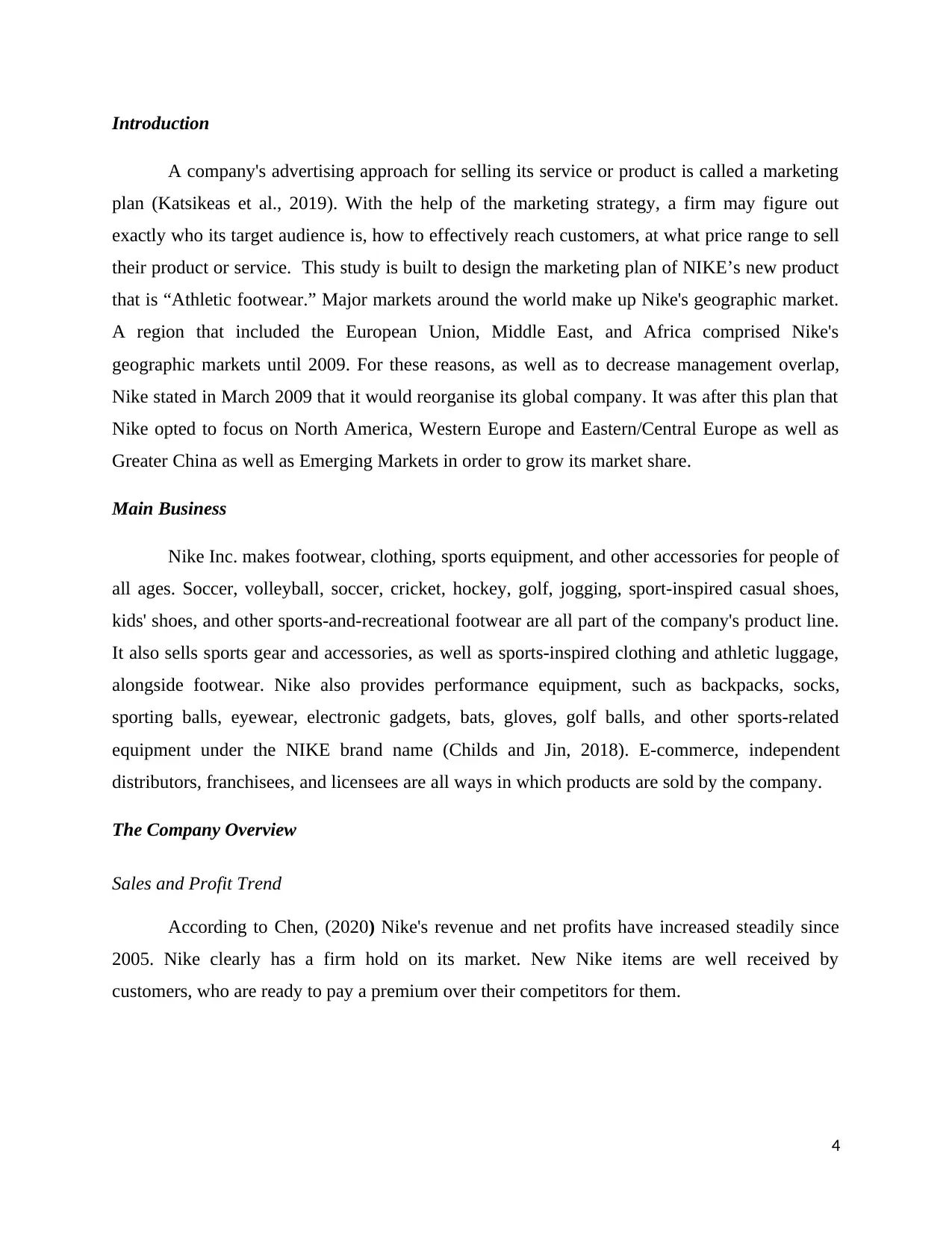
Introduction
A company's advertising approach for selling its service or product is called a marketing
plan (Katsikeas et al., 2019). With the help of the marketing strategy, a firm may figure out
exactly who its target audience is, how to effectively reach customers, at what price range to sell
their product or service. This study is built to design the marketing plan of NIKE’s new product
that is “Athletic footwear.” Major markets around the world make up Nike's geographic market.
A region that included the European Union, Middle East, and Africa comprised Nike's
geographic markets until 2009. For these reasons, as well as to decrease management overlap,
Nike stated in March 2009 that it would reorganise its global company. It was after this plan that
Nike opted to focus on North America, Western Europe and Eastern/Central Europe as well as
Greater China as well as Emerging Markets in order to grow its market share.
Main Business
Nike Inc. makes footwear, clothing, sports equipment, and other accessories for people of
all ages. Soccer, volleyball, soccer, cricket, hockey, golf, jogging, sport-inspired casual shoes,
kids' shoes, and other sports-and-recreational footwear are all part of the company's product line.
It also sells sports gear and accessories, as well as sports-inspired clothing and athletic luggage,
alongside footwear. Nike also provides performance equipment, such as backpacks, socks,
sporting balls, eyewear, electronic gadgets, bats, gloves, golf balls, and other sports-related
equipment under the NIKE brand name (Childs and Jin, 2018). E-commerce, independent
distributors, franchisees, and licensees are all ways in which products are sold by the company.
The Company Overview
Sales and Profit Trend
According to Chen, (2020) Nike's revenue and net profits have increased steadily since
2005. Nike clearly has a firm hold on its market. New Nike items are well received by
customers, who are ready to pay a premium over their competitors for them.
4
A company's advertising approach for selling its service or product is called a marketing
plan (Katsikeas et al., 2019). With the help of the marketing strategy, a firm may figure out
exactly who its target audience is, how to effectively reach customers, at what price range to sell
their product or service. This study is built to design the marketing plan of NIKE’s new product
that is “Athletic footwear.” Major markets around the world make up Nike's geographic market.
A region that included the European Union, Middle East, and Africa comprised Nike's
geographic markets until 2009. For these reasons, as well as to decrease management overlap,
Nike stated in March 2009 that it would reorganise its global company. It was after this plan that
Nike opted to focus on North America, Western Europe and Eastern/Central Europe as well as
Greater China as well as Emerging Markets in order to grow its market share.
Main Business
Nike Inc. makes footwear, clothing, sports equipment, and other accessories for people of
all ages. Soccer, volleyball, soccer, cricket, hockey, golf, jogging, sport-inspired casual shoes,
kids' shoes, and other sports-and-recreational footwear are all part of the company's product line.
It also sells sports gear and accessories, as well as sports-inspired clothing and athletic luggage,
alongside footwear. Nike also provides performance equipment, such as backpacks, socks,
sporting balls, eyewear, electronic gadgets, bats, gloves, golf balls, and other sports-related
equipment under the NIKE brand name (Childs and Jin, 2018). E-commerce, independent
distributors, franchisees, and licensees are all ways in which products are sold by the company.
The Company Overview
Sales and Profit Trend
According to Chen, (2020) Nike's revenue and net profits have increased steadily since
2005. Nike clearly has a firm hold on its market. New Nike items are well received by
customers, who are ready to pay a premium over their competitors for them.
4
Paraphrase This Document
Need a fresh take? Get an instant paraphrase of this document with our AI Paraphraser
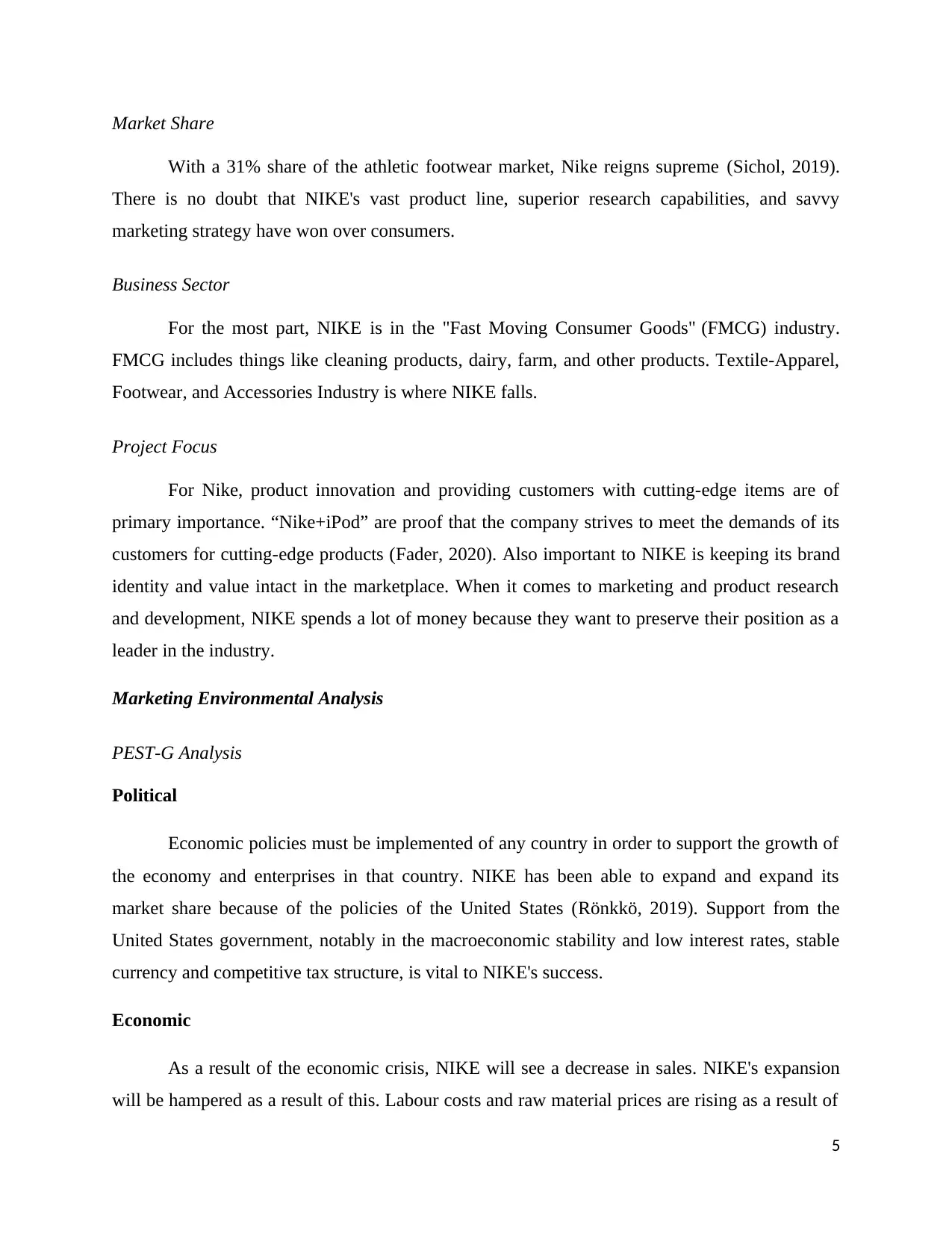
Market Share
With a 31% share of the athletic footwear market, Nike reigns supreme (Sichol, 2019).
There is no doubt that NIKE's vast product line, superior research capabilities, and savvy
marketing strategy have won over consumers.
Business Sector
For the most part, NIKE is in the "Fast Moving Consumer Goods" (FMCG) industry.
FMCG includes things like cleaning products, dairy, farm, and other products. Textile-Apparel,
Footwear, and Accessories Industry is where NIKE falls.
Project Focus
For Nike, product innovation and providing customers with cutting-edge items are of
primary importance. “Nike+iPod” are proof that the company strives to meet the demands of its
customers for cutting-edge products (Fader, 2020). Also important to NIKE is keeping its brand
identity and value intact in the marketplace. When it comes to marketing and product research
and development, NIKE spends a lot of money because they want to preserve their position as a
leader in the industry.
Marketing Environmental Analysis
PEST-G Analysis
Political
Economic policies must be implemented of any country in order to support the growth of
the economy and enterprises in that country. NIKE has been able to expand and expand its
market share because of the policies of the United States (Rönkkö, 2019). Support from the
United States government, notably in the macroeconomic stability and low interest rates, stable
currency and competitive tax structure, is vital to NIKE's success.
Economic
As a result of the economic crisis, NIKE will see a decrease in sales. NIKE's expansion
will be hampered as a result of this. Labour costs and raw material prices are rising as a result of
5
With a 31% share of the athletic footwear market, Nike reigns supreme (Sichol, 2019).
There is no doubt that NIKE's vast product line, superior research capabilities, and savvy
marketing strategy have won over consumers.
Business Sector
For the most part, NIKE is in the "Fast Moving Consumer Goods" (FMCG) industry.
FMCG includes things like cleaning products, dairy, farm, and other products. Textile-Apparel,
Footwear, and Accessories Industry is where NIKE falls.
Project Focus
For Nike, product innovation and providing customers with cutting-edge items are of
primary importance. “Nike+iPod” are proof that the company strives to meet the demands of its
customers for cutting-edge products (Fader, 2020). Also important to NIKE is keeping its brand
identity and value intact in the marketplace. When it comes to marketing and product research
and development, NIKE spends a lot of money because they want to preserve their position as a
leader in the industry.
Marketing Environmental Analysis
PEST-G Analysis
Political
Economic policies must be implemented of any country in order to support the growth of
the economy and enterprises in that country. NIKE has been able to expand and expand its
market share because of the policies of the United States (Rönkkö, 2019). Support from the
United States government, notably in the macroeconomic stability and low interest rates, stable
currency and competitive tax structure, is vital to NIKE's success.
Economic
As a result of the economic crisis, NIKE will see a decrease in sales. NIKE's expansion
will be hampered as a result of this. Labour costs and raw material prices are rising as a result of
5
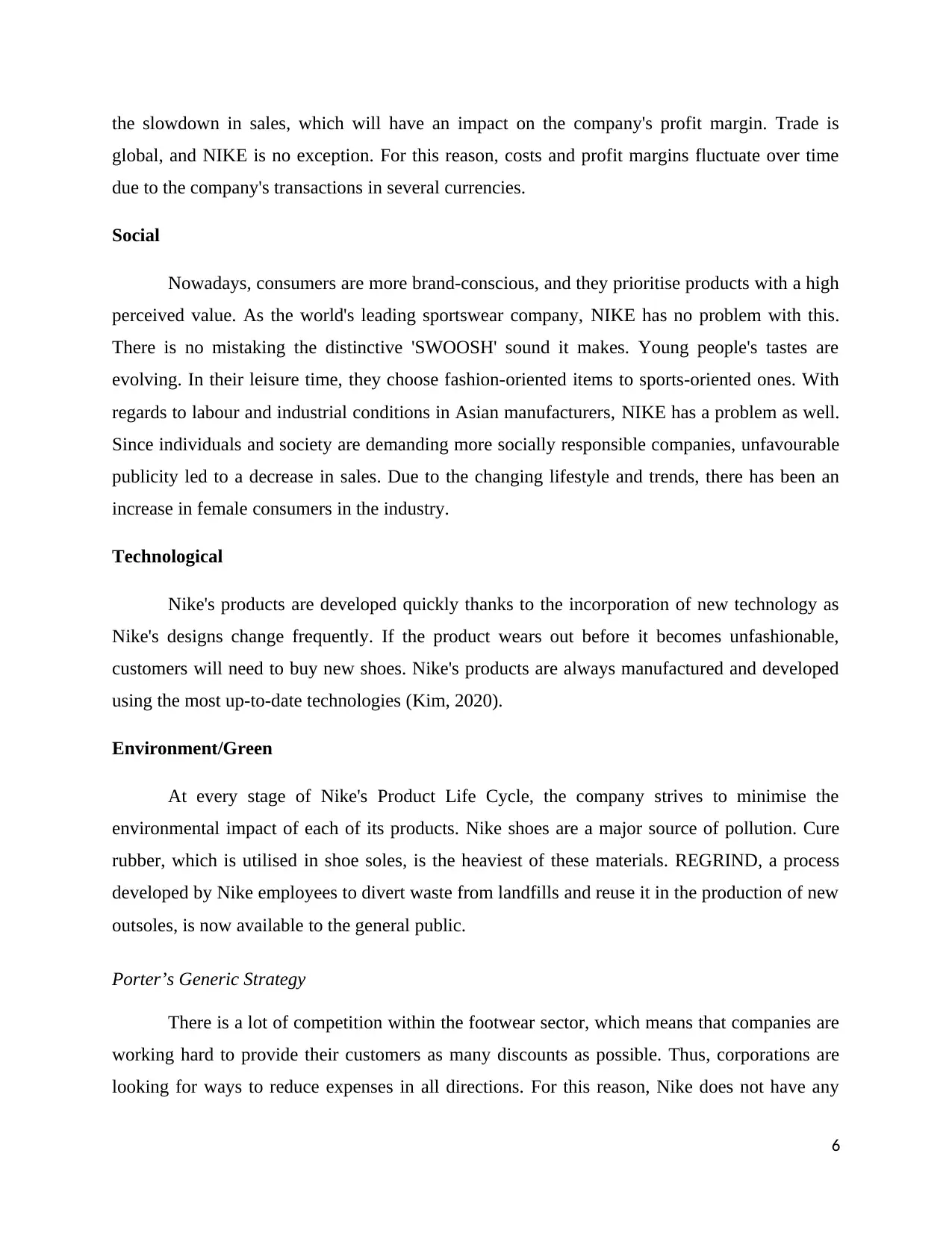
the slowdown in sales, which will have an impact on the company's profit margin. Trade is
global, and NIKE is no exception. For this reason, costs and profit margins fluctuate over time
due to the company's transactions in several currencies.
Social
Nowadays, consumers are more brand-conscious, and they prioritise products with a high
perceived value. As the world's leading sportswear company, NIKE has no problem with this.
There is no mistaking the distinctive 'SWOOSH' sound it makes. Young people's tastes are
evolving. In their leisure time, they choose fashion-oriented items to sports-oriented ones. With
regards to labour and industrial conditions in Asian manufacturers, NIKE has a problem as well.
Since individuals and society are demanding more socially responsible companies, unfavourable
publicity led to a decrease in sales. Due to the changing lifestyle and trends, there has been an
increase in female consumers in the industry.
Technological
Nike's products are developed quickly thanks to the incorporation of new technology as
Nike's designs change frequently. If the product wears out before it becomes unfashionable,
customers will need to buy new shoes. Nike's products are always manufactured and developed
using the most up-to-date technologies (Kim, 2020).
Environment/Green
At every stage of Nike's Product Life Cycle, the company strives to minimise the
environmental impact of each of its products. Nike shoes are a major source of pollution. Cure
rubber, which is utilised in shoe soles, is the heaviest of these materials. REGRIND, a process
developed by Nike employees to divert waste from landfills and reuse it in the production of new
outsoles, is now available to the general public.
Porter’s Generic Strategy
There is a lot of competition within the footwear sector, which means that companies are
working hard to provide their customers as many discounts as possible. Thus, corporations are
looking for ways to reduce expenses in all directions. For this reason, Nike does not have any
6
global, and NIKE is no exception. For this reason, costs and profit margins fluctuate over time
due to the company's transactions in several currencies.
Social
Nowadays, consumers are more brand-conscious, and they prioritise products with a high
perceived value. As the world's leading sportswear company, NIKE has no problem with this.
There is no mistaking the distinctive 'SWOOSH' sound it makes. Young people's tastes are
evolving. In their leisure time, they choose fashion-oriented items to sports-oriented ones. With
regards to labour and industrial conditions in Asian manufacturers, NIKE has a problem as well.
Since individuals and society are demanding more socially responsible companies, unfavourable
publicity led to a decrease in sales. Due to the changing lifestyle and trends, there has been an
increase in female consumers in the industry.
Technological
Nike's products are developed quickly thanks to the incorporation of new technology as
Nike's designs change frequently. If the product wears out before it becomes unfashionable,
customers will need to buy new shoes. Nike's products are always manufactured and developed
using the most up-to-date technologies (Kim, 2020).
Environment/Green
At every stage of Nike's Product Life Cycle, the company strives to minimise the
environmental impact of each of its products. Nike shoes are a major source of pollution. Cure
rubber, which is utilised in shoe soles, is the heaviest of these materials. REGRIND, a process
developed by Nike employees to divert waste from landfills and reuse it in the production of new
outsoles, is now available to the general public.
Porter’s Generic Strategy
There is a lot of competition within the footwear sector, which means that companies are
working hard to provide their customers as many discounts as possible. Thus, corporations are
looking for ways to reduce expenses in all directions. For this reason, Nike does not have any
6
⊘ This is a preview!⊘
Do you want full access?
Subscribe today to unlock all pages.

Trusted by 1+ million students worldwide
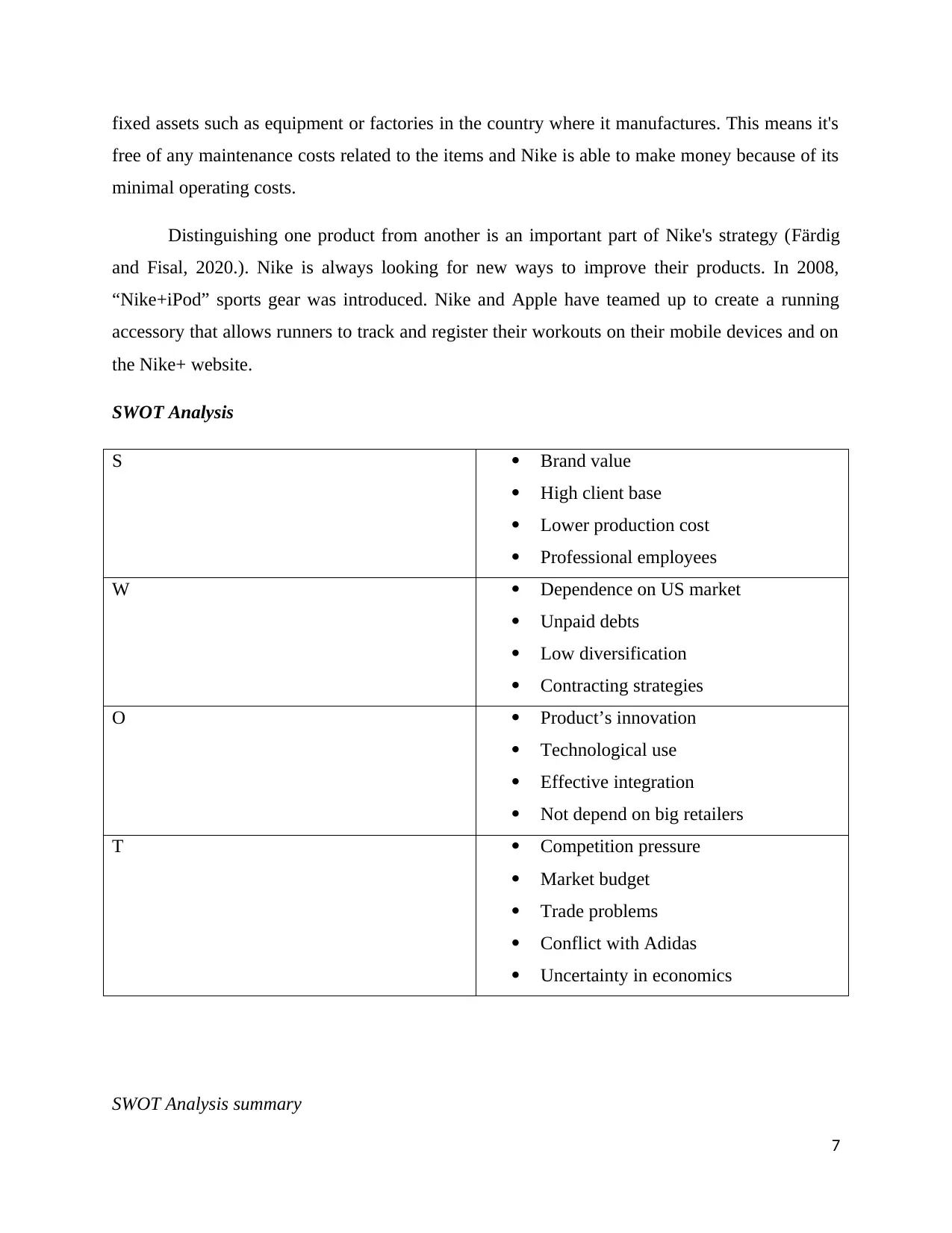
fixed assets such as equipment or factories in the country where it manufactures. This means it's
free of any maintenance costs related to the items and Nike is able to make money because of its
minimal operating costs.
Distinguishing one product from another is an important part of Nike's strategy (Färdig
and Fisal, 2020.). Nike is always looking for new ways to improve their products. In 2008,
“Nike+iPod” sports gear was introduced. Nike and Apple have teamed up to create a running
accessory that allows runners to track and register their workouts on their mobile devices and on
the Nike+ website.
SWOT Analysis
S Brand value
High client base
Lower production cost
Professional employees
W Dependence on US market
Unpaid debts
Low diversification
Contracting strategies
O Product’s innovation
Technological use
Effective integration
Not depend on big retailers
T Competition pressure
Market budget
Trade problems
Conflict with Adidas
Uncertainty in economics
SWOT Analysis summary
7
free of any maintenance costs related to the items and Nike is able to make money because of its
minimal operating costs.
Distinguishing one product from another is an important part of Nike's strategy (Färdig
and Fisal, 2020.). Nike is always looking for new ways to improve their products. In 2008,
“Nike+iPod” sports gear was introduced. Nike and Apple have teamed up to create a running
accessory that allows runners to track and register their workouts on their mobile devices and on
the Nike+ website.
SWOT Analysis
S Brand value
High client base
Lower production cost
Professional employees
W Dependence on US market
Unpaid debts
Low diversification
Contracting strategies
O Product’s innovation
Technological use
Effective integration
Not depend on big retailers
T Competition pressure
Market budget
Trade problems
Conflict with Adidas
Uncertainty in economics
SWOT Analysis summary
7
Paraphrase This Document
Need a fresh take? Get an instant paraphrase of this document with our AI Paraphraser
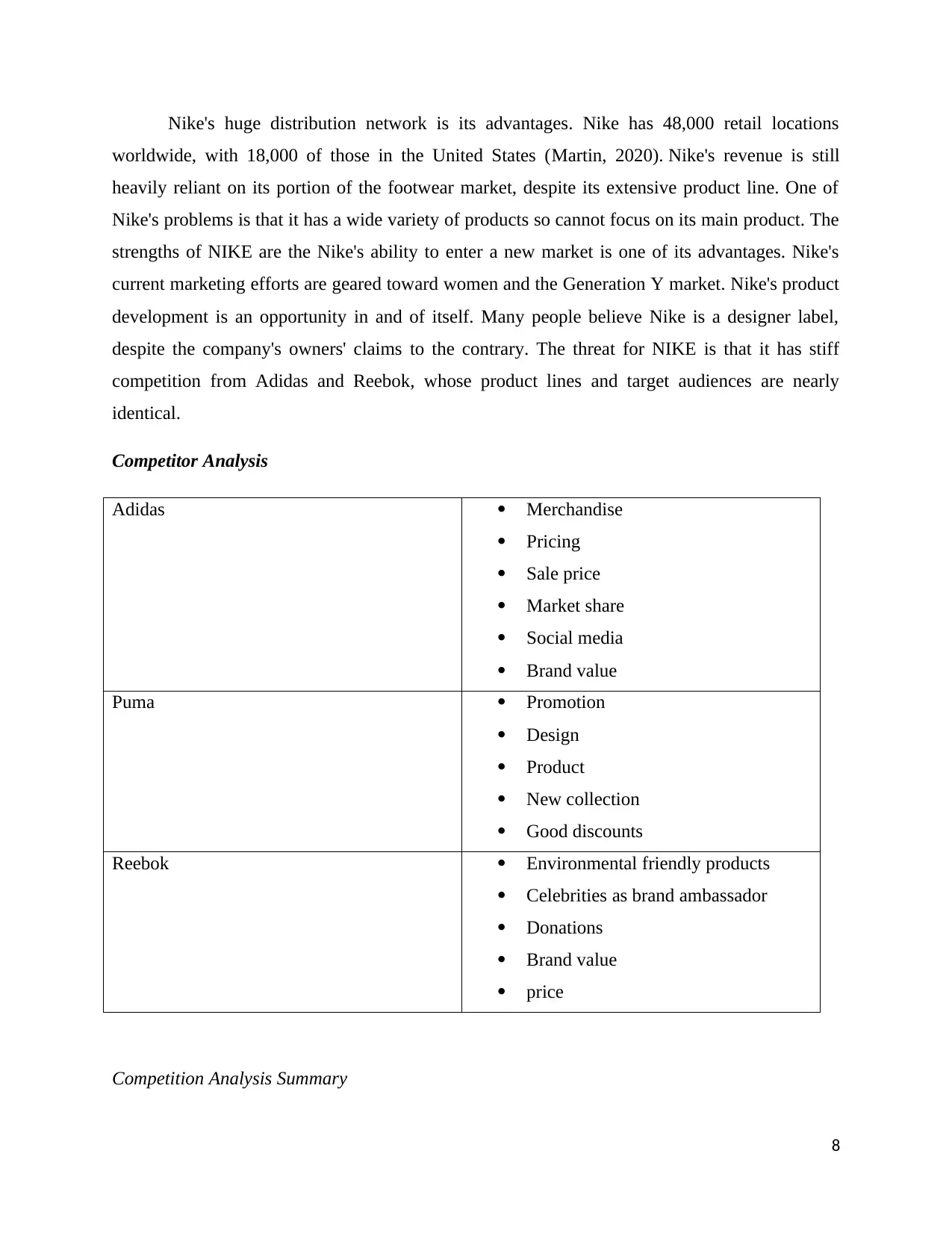
Nike's huge distribution network is its advantages. Nike has 48,000 retail locations
worldwide, with 18,000 of those in the United States (Martin, 2020). Nike's revenue is still
heavily reliant on its portion of the footwear market, despite its extensive product line. One of
Nike's problems is that it has a wide variety of products so cannot focus on its main product. The
strengths of NIKE are the Nike's ability to enter a new market is one of its advantages. Nike's
current marketing efforts are geared toward women and the Generation Y market. Nike's product
development is an opportunity in and of itself. Many people believe Nike is a designer label,
despite the company's owners' claims to the contrary. The threat for NIKE is that it has stiff
competition from Adidas and Reebok, whose product lines and target audiences are nearly
identical.
Competitor Analysis
Adidas Merchandise
Pricing
Sale price
Market share
Social media
Brand value
Puma Promotion
Design
Product
New collection
Good discounts
Reebok Environmental friendly products
Celebrities as brand ambassador
Donations
Brand value
price
Competition Analysis Summary
8
worldwide, with 18,000 of those in the United States (Martin, 2020). Nike's revenue is still
heavily reliant on its portion of the footwear market, despite its extensive product line. One of
Nike's problems is that it has a wide variety of products so cannot focus on its main product. The
strengths of NIKE are the Nike's ability to enter a new market is one of its advantages. Nike's
current marketing efforts are geared toward women and the Generation Y market. Nike's product
development is an opportunity in and of itself. Many people believe Nike is a designer label,
despite the company's owners' claims to the contrary. The threat for NIKE is that it has stiff
competition from Adidas and Reebok, whose product lines and target audiences are nearly
identical.
Competitor Analysis
Adidas Merchandise
Pricing
Sale price
Market share
Social media
Brand value
Puma Promotion
Design
Product
New collection
Good discounts
Reebok Environmental friendly products
Celebrities as brand ambassador
Donations
Brand value
price
Competition Analysis Summary
8
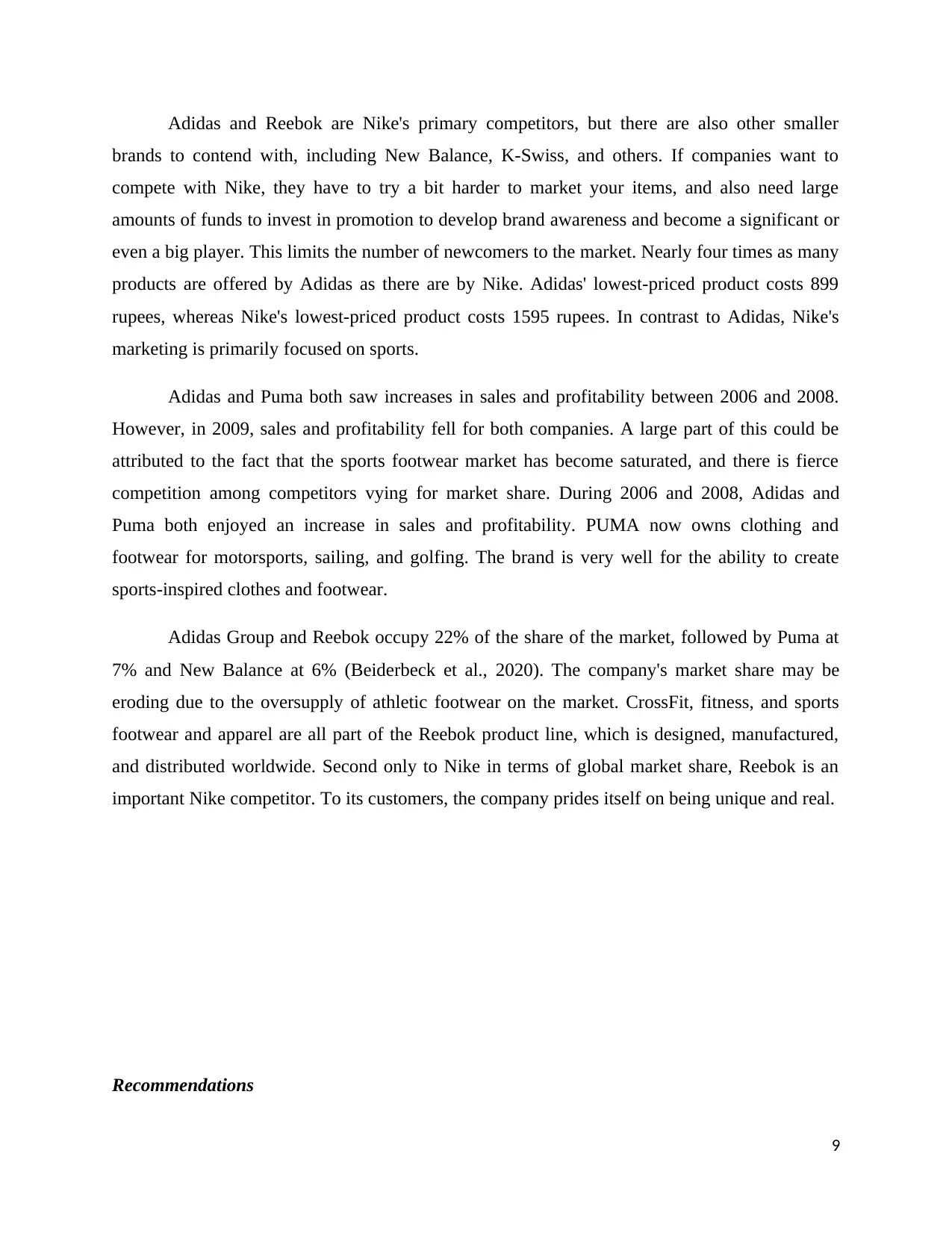
Adidas and Reebok are Nike's primary competitors, but there are also other smaller
brands to contend with, including New Balance, K-Swiss, and others. If companies want to
compete with Nike, they have to try a bit harder to market your items, and also need large
amounts of funds to invest in promotion to develop brand awareness and become a significant or
even a big player. This limits the number of newcomers to the market. Nearly four times as many
products are offered by Adidas as there are by Nike. Adidas' lowest-priced product costs 899
rupees, whereas Nike's lowest-priced product costs 1595 rupees. In contrast to Adidas, Nike's
marketing is primarily focused on sports.
Adidas and Puma both saw increases in sales and profitability between 2006 and 2008.
However, in 2009, sales and profitability fell for both companies. A large part of this could be
attributed to the fact that the sports footwear market has become saturated, and there is fierce
competition among competitors vying for market share. During 2006 and 2008, Adidas and
Puma both enjoyed an increase in sales and profitability. PUMA now owns clothing and
footwear for motorsports, sailing, and golfing. The brand is very well for the ability to create
sports-inspired clothes and footwear.
Adidas Group and Reebok occupy 22% of the share of the market, followed by Puma at
7% and New Balance at 6% (Beiderbeck et al., 2020). The company's market share may be
eroding due to the oversupply of athletic footwear on the market. CrossFit, fitness, and sports
footwear and apparel are all part of the Reebok product line, which is designed, manufactured,
and distributed worldwide. Second only to Nike in terms of global market share, Reebok is an
important Nike competitor. To its customers, the company prides itself on being unique and real.
Recommendations
9
brands to contend with, including New Balance, K-Swiss, and others. If companies want to
compete with Nike, they have to try a bit harder to market your items, and also need large
amounts of funds to invest in promotion to develop brand awareness and become a significant or
even a big player. This limits the number of newcomers to the market. Nearly four times as many
products are offered by Adidas as there are by Nike. Adidas' lowest-priced product costs 899
rupees, whereas Nike's lowest-priced product costs 1595 rupees. In contrast to Adidas, Nike's
marketing is primarily focused on sports.
Adidas and Puma both saw increases in sales and profitability between 2006 and 2008.
However, in 2009, sales and profitability fell for both companies. A large part of this could be
attributed to the fact that the sports footwear market has become saturated, and there is fierce
competition among competitors vying for market share. During 2006 and 2008, Adidas and
Puma both enjoyed an increase in sales and profitability. PUMA now owns clothing and
footwear for motorsports, sailing, and golfing. The brand is very well for the ability to create
sports-inspired clothes and footwear.
Adidas Group and Reebok occupy 22% of the share of the market, followed by Puma at
7% and New Balance at 6% (Beiderbeck et al., 2020). The company's market share may be
eroding due to the oversupply of athletic footwear on the market. CrossFit, fitness, and sports
footwear and apparel are all part of the Reebok product line, which is designed, manufactured,
and distributed worldwide. Second only to Nike in terms of global market share, Reebok is an
important Nike competitor. To its customers, the company prides itself on being unique and real.
Recommendations
9
⊘ This is a preview!⊘
Do you want full access?
Subscribe today to unlock all pages.

Trusted by 1+ million students worldwide
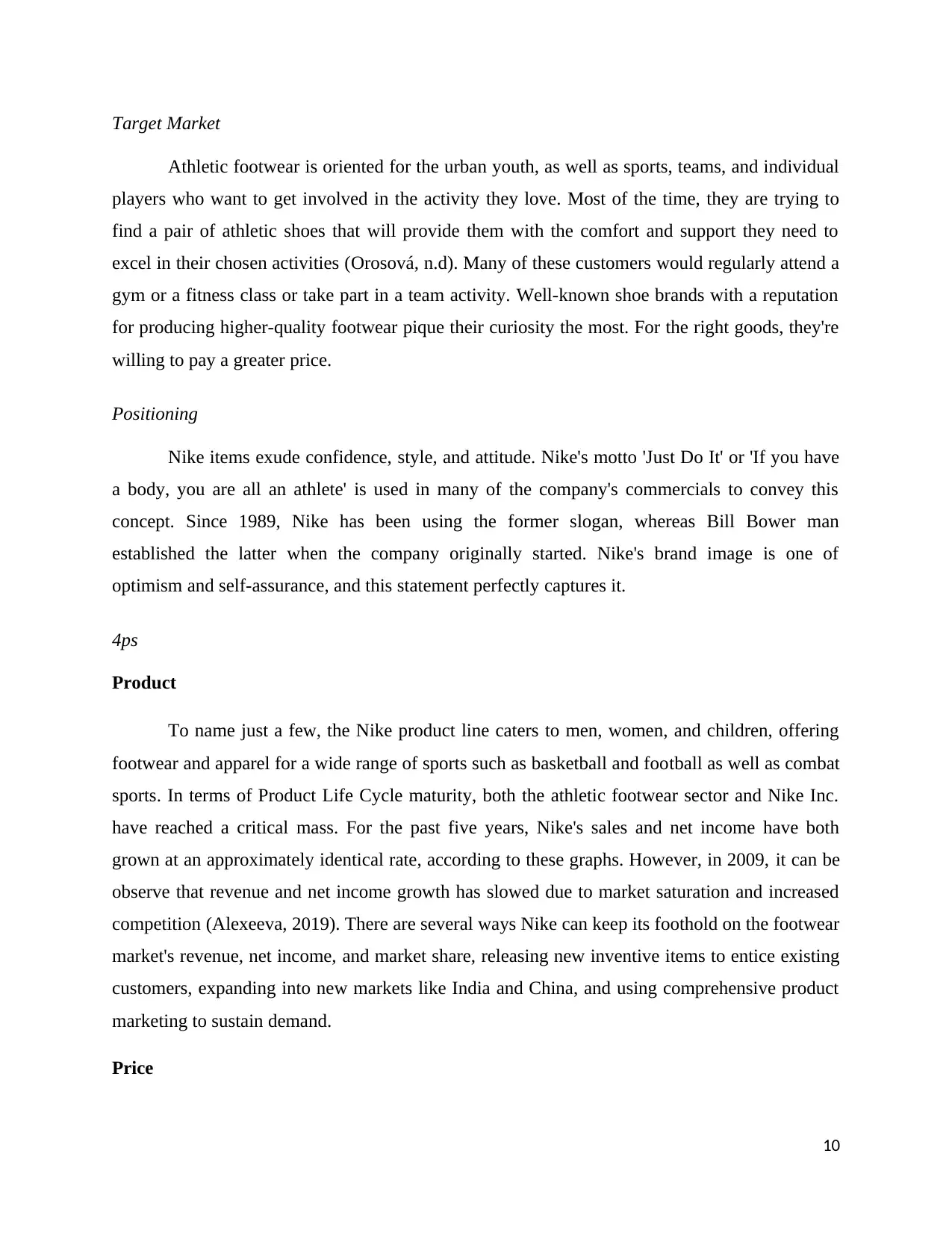
Target Market
Athletic footwear is oriented for the urban youth, as well as sports, teams, and individual
players who want to get involved in the activity they love. Most of the time, they are trying to
find a pair of athletic shoes that will provide them with the comfort and support they need to
excel in their chosen activities (Orosová, n.d). Many of these customers would regularly attend a
gym or a fitness class or take part in a team activity. Well-known shoe brands with a reputation
for producing higher-quality footwear pique their curiosity the most. For the right goods, they're
willing to pay a greater price.
Positioning
Nike items exude confidence, style, and attitude. Nike's motto 'Just Do It' or 'If you have
a body, you are all an athlete' is used in many of the company's commercials to convey this
concept. Since 1989, Nike has been using the former slogan, whereas Bill Bower man
established the latter when the company originally started. Nike's brand image is one of
optimism and self-assurance, and this statement perfectly captures it.
4ps
Product
To name just a few, the Nike product line caters to men, women, and children, offering
footwear and apparel for a wide range of sports such as basketball and football as well as combat
sports. In terms of Product Life Cycle maturity, both the athletic footwear sector and Nike Inc.
have reached a critical mass. For the past five years, Nike's sales and net income have both
grown at an approximately identical rate, according to these graphs. However, in 2009, it can be
observe that revenue and net income growth has slowed due to market saturation and increased
competition (Alexeeva, 2019). There are several ways Nike can keep its foothold on the footwear
market's revenue, net income, and market share, releasing new inventive items to entice existing
customers, expanding into new markets like India and China, and using comprehensive product
marketing to sustain demand.
Price
10
Athletic footwear is oriented for the urban youth, as well as sports, teams, and individual
players who want to get involved in the activity they love. Most of the time, they are trying to
find a pair of athletic shoes that will provide them with the comfort and support they need to
excel in their chosen activities (Orosová, n.d). Many of these customers would regularly attend a
gym or a fitness class or take part in a team activity. Well-known shoe brands with a reputation
for producing higher-quality footwear pique their curiosity the most. For the right goods, they're
willing to pay a greater price.
Positioning
Nike items exude confidence, style, and attitude. Nike's motto 'Just Do It' or 'If you have
a body, you are all an athlete' is used in many of the company's commercials to convey this
concept. Since 1989, Nike has been using the former slogan, whereas Bill Bower man
established the latter when the company originally started. Nike's brand image is one of
optimism and self-assurance, and this statement perfectly captures it.
4ps
Product
To name just a few, the Nike product line caters to men, women, and children, offering
footwear and apparel for a wide range of sports such as basketball and football as well as combat
sports. In terms of Product Life Cycle maturity, both the athletic footwear sector and Nike Inc.
have reached a critical mass. For the past five years, Nike's sales and net income have both
grown at an approximately identical rate, according to these graphs. However, in 2009, it can be
observe that revenue and net income growth has slowed due to market saturation and increased
competition (Alexeeva, 2019). There are several ways Nike can keep its foothold on the footwear
market's revenue, net income, and market share, releasing new inventive items to entice existing
customers, expanding into new markets like India and China, and using comprehensive product
marketing to sustain demand.
Price
10
Paraphrase This Document
Need a fresh take? Get an instant paraphrase of this document with our AI Paraphraser
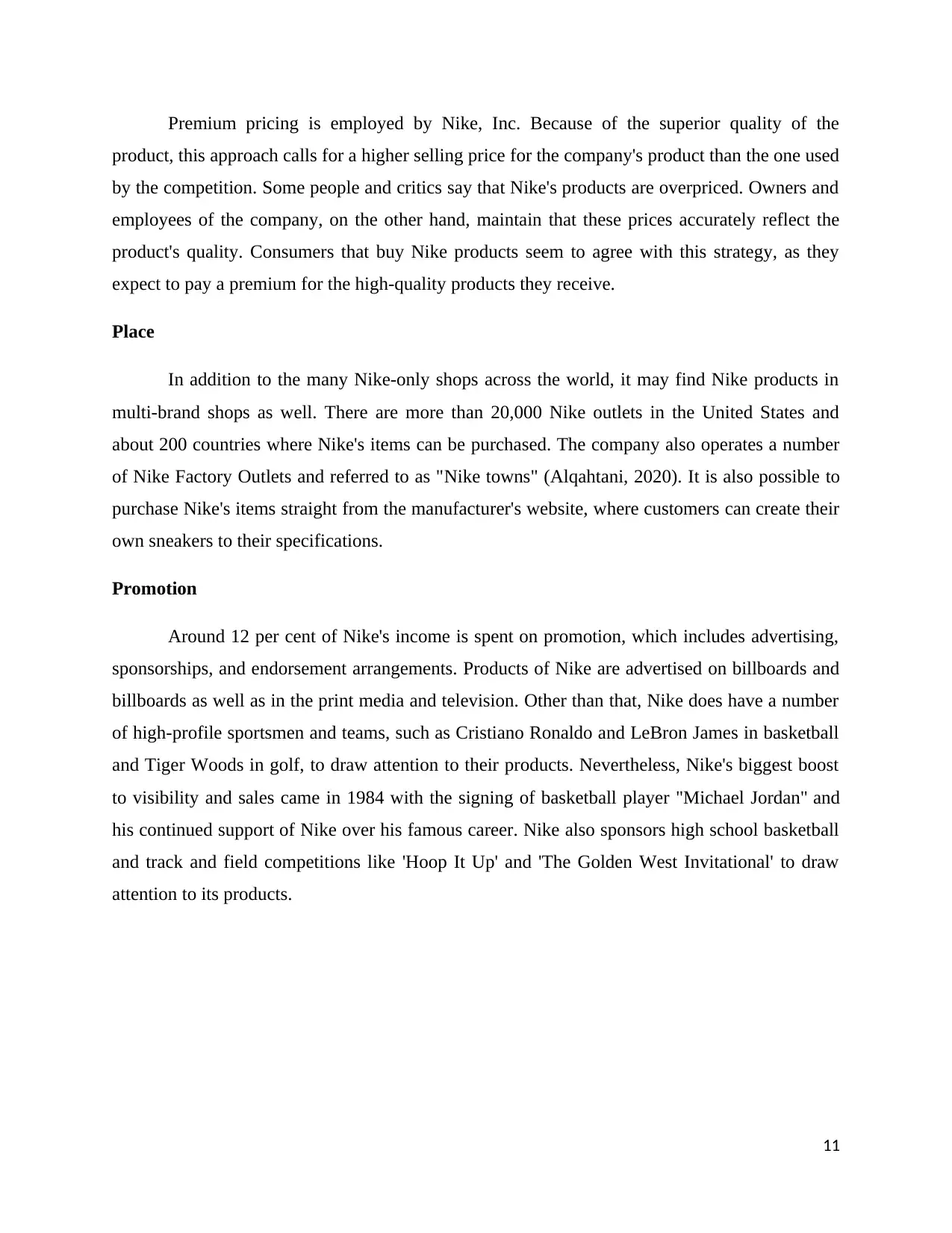
Premium pricing is employed by Nike, Inc. Because of the superior quality of the
product, this approach calls for a higher selling price for the company's product than the one used
by the competition. Some people and critics say that Nike's products are overpriced. Owners and
employees of the company, on the other hand, maintain that these prices accurately reflect the
product's quality. Consumers that buy Nike products seem to agree with this strategy, as they
expect to pay a premium for the high-quality products they receive.
Place
In addition to the many Nike-only shops across the world, it may find Nike products in
multi-brand shops as well. There are more than 20,000 Nike outlets in the United States and
about 200 countries where Nike's items can be purchased. The company also operates a number
of Nike Factory Outlets and referred to as "Nike towns" (Alqahtani, 2020). It is also possible to
purchase Nike's items straight from the manufacturer's website, where customers can create their
own sneakers to their specifications.
Promotion
Around 12 per cent of Nike's income is spent on promotion, which includes advertising,
sponsorships, and endorsement arrangements. Products of Nike are advertised on billboards and
billboards as well as in the print media and television. Other than that, Nike does have a number
of high-profile sportsmen and teams, such as Cristiano Ronaldo and LeBron James in basketball
and Tiger Woods in golf, to draw attention to their products. Nevertheless, Nike's biggest boost
to visibility and sales came in 1984 with the signing of basketball player "Michael Jordan" and
his continued support of Nike over his famous career. Nike also sponsors high school basketball
and track and field competitions like 'Hoop It Up' and 'The Golden West Invitational' to draw
attention to its products.
11
product, this approach calls for a higher selling price for the company's product than the one used
by the competition. Some people and critics say that Nike's products are overpriced. Owners and
employees of the company, on the other hand, maintain that these prices accurately reflect the
product's quality. Consumers that buy Nike products seem to agree with this strategy, as they
expect to pay a premium for the high-quality products they receive.
Place
In addition to the many Nike-only shops across the world, it may find Nike products in
multi-brand shops as well. There are more than 20,000 Nike outlets in the United States and
about 200 countries where Nike's items can be purchased. The company also operates a number
of Nike Factory Outlets and referred to as "Nike towns" (Alqahtani, 2020). It is also possible to
purchase Nike's items straight from the manufacturer's website, where customers can create their
own sneakers to their specifications.
Promotion
Around 12 per cent of Nike's income is spent on promotion, which includes advertising,
sponsorships, and endorsement arrangements. Products of Nike are advertised on billboards and
billboards as well as in the print media and television. Other than that, Nike does have a number
of high-profile sportsmen and teams, such as Cristiano Ronaldo and LeBron James in basketball
and Tiger Woods in golf, to draw attention to their products. Nevertheless, Nike's biggest boost
to visibility and sales came in 1984 with the signing of basketball player "Michael Jordan" and
his continued support of Nike over his famous career. Nike also sponsors high school basketball
and track and field competitions like 'Hoop It Up' and 'The Golden West Invitational' to draw
attention to its products.
11
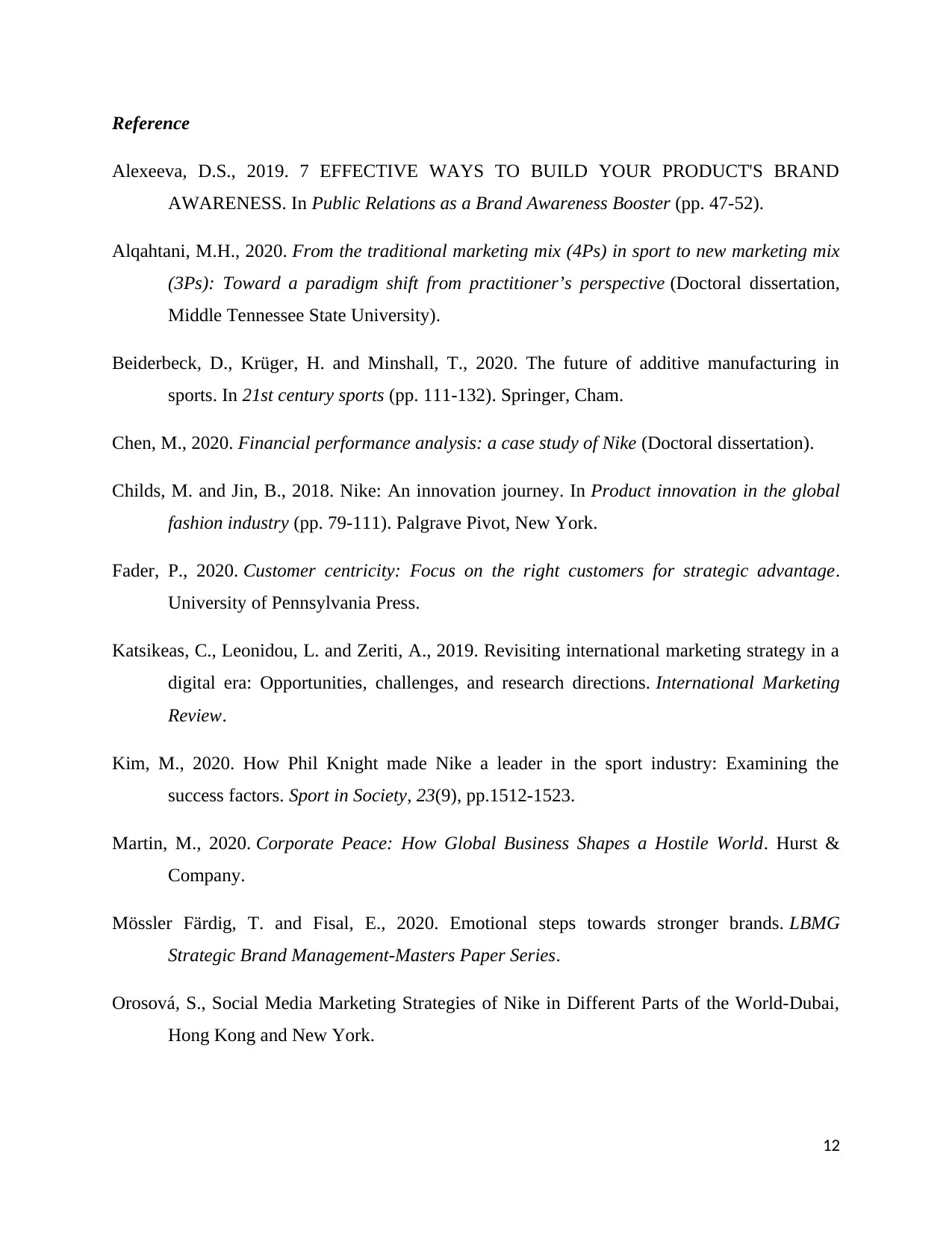
Reference
Alexeeva, D.S., 2019. 7 EFFECTIVE WAYS TO BUILD YOUR PRODUCT'S BRAND
AWARENESS. In Public Relations as a Brand Awareness Booster (pp. 47-52).
Alqahtani, M.H., 2020. From the traditional marketing mix (4Ps) in sport to new marketing mix
(3Ps): Toward a paradigm shift from practitioner’s perspective (Doctoral dissertation,
Middle Tennessee State University).
Beiderbeck, D., Krüger, H. and Minshall, T., 2020. The future of additive manufacturing in
sports. In 21st century sports (pp. 111-132). Springer, Cham.
Chen, M., 2020. Financial performance analysis: a case study of Nike (Doctoral dissertation).
Childs, M. and Jin, B., 2018. Nike: An innovation journey. In Product innovation in the global
fashion industry (pp. 79-111). Palgrave Pivot, New York.
Fader, P., 2020. Customer centricity: Focus on the right customers for strategic advantage.
University of Pennsylvania Press.
Katsikeas, C., Leonidou, L. and Zeriti, A., 2019. Revisiting international marketing strategy in a
digital era: Opportunities, challenges, and research directions. International Marketing
Review.
Kim, M., 2020. How Phil Knight made Nike a leader in the sport industry: Examining the
success factors. Sport in Society, 23(9), pp.1512-1523.
Martin, M., 2020. Corporate Peace: How Global Business Shapes a Hostile World. Hurst &
Company.
Mössler Färdig, T. and Fisal, E., 2020. Emotional steps towards stronger brands. LBMG
Strategic Brand Management-Masters Paper Series.
Orosová, S., Social Media Marketing Strategies of Nike in Different Parts of the World-Dubai,
Hong Kong and New York.
12
Alexeeva, D.S., 2019. 7 EFFECTIVE WAYS TO BUILD YOUR PRODUCT'S BRAND
AWARENESS. In Public Relations as a Brand Awareness Booster (pp. 47-52).
Alqahtani, M.H., 2020. From the traditional marketing mix (4Ps) in sport to new marketing mix
(3Ps): Toward a paradigm shift from practitioner’s perspective (Doctoral dissertation,
Middle Tennessee State University).
Beiderbeck, D., Krüger, H. and Minshall, T., 2020. The future of additive manufacturing in
sports. In 21st century sports (pp. 111-132). Springer, Cham.
Chen, M., 2020. Financial performance analysis: a case study of Nike (Doctoral dissertation).
Childs, M. and Jin, B., 2018. Nike: An innovation journey. In Product innovation in the global
fashion industry (pp. 79-111). Palgrave Pivot, New York.
Fader, P., 2020. Customer centricity: Focus on the right customers for strategic advantage.
University of Pennsylvania Press.
Katsikeas, C., Leonidou, L. and Zeriti, A., 2019. Revisiting international marketing strategy in a
digital era: Opportunities, challenges, and research directions. International Marketing
Review.
Kim, M., 2020. How Phil Knight made Nike a leader in the sport industry: Examining the
success factors. Sport in Society, 23(9), pp.1512-1523.
Martin, M., 2020. Corporate Peace: How Global Business Shapes a Hostile World. Hurst &
Company.
Mössler Färdig, T. and Fisal, E., 2020. Emotional steps towards stronger brands. LBMG
Strategic Brand Management-Masters Paper Series.
Orosová, S., Social Media Marketing Strategies of Nike in Different Parts of the World-Dubai,
Hong Kong and New York.
12
⊘ This is a preview!⊘
Do you want full access?
Subscribe today to unlock all pages.

Trusted by 1+ million students worldwide
1 out of 13
Related Documents
Your All-in-One AI-Powered Toolkit for Academic Success.
+13062052269
info@desklib.com
Available 24*7 on WhatsApp / Email
![[object Object]](/_next/static/media/star-bottom.7253800d.svg)
Unlock your academic potential
Copyright © 2020–2025 A2Z Services. All Rights Reserved. Developed and managed by ZUCOL.





